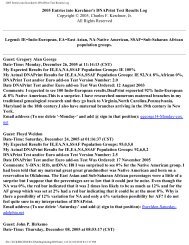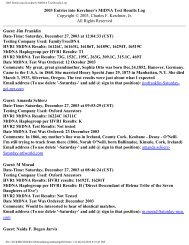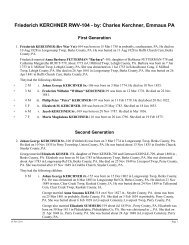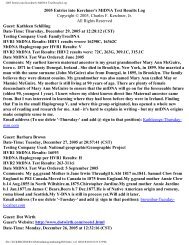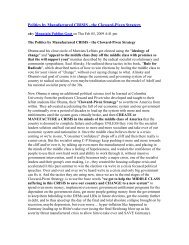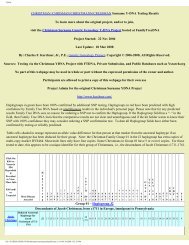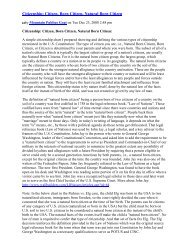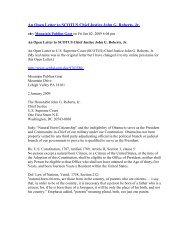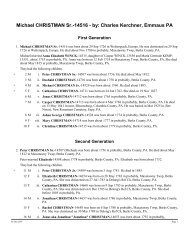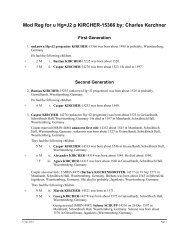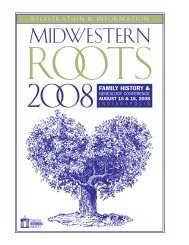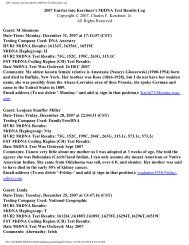2004 Entries into Kerchner's MtDNA Test Results Log
2004 Entries into Kerchner's MtDNA Test Results Log
2004 Entries into Kerchner's MtDNA Test Results Log
Create successful ePaper yourself
Turn your PDF publications into a flip-book with our unique Google optimized e-Paper software.
Guest: Thomas E. Spencer, Jr.<br />
Date-Time: Monday, May 03, <strong>2004</strong> at 19:36:06 (CDT)<br />
<strong>Test</strong>ing Company Used: FamilyTreeDNA<br />
HVR1 <strong>MtDNA</strong> <strong>Results</strong>: 16235G, 16291T, 16357C<br />
<strong>MtDNA</strong> Haplogroup per HVR1 <strong>Results</strong>: H<br />
HVR2 <strong>MtDNA</strong> <strong>Test</strong> <strong>Results</strong>:<br />
Date <strong>MtDNA</strong> <strong>Test</strong> Was Ordered: April 29, <strong>2004</strong><br />
Comments: The oldest known direct line Maternal ancestor was my great great<br />
grandmother Juliana Ellison Farrow from Hyde County, North Carolina (born Feb.<br />
4, 1840-died May 30, 1907. I know her mother's name (Eleanor Smaw) but I don't<br />
know her birth or death dates. I believe the family was from the British Isles. I wish<br />
somebody would explain the meaning of my genetic mutations? Does it specify a<br />
specific geographic location where the change took place. FamilytreeDNA is great<br />
about explaining surname studies, but Oxford Ancestry is better at explaining<br />
mitochodria DNA, but you have to take their tests before they'll explain a lot to you.<br />
I could not find anyone in their free message board that had the same mutations. All<br />
I'm sure of is that I'm a member of the Helen clan, and I had to learn that from<br />
Oxford Ancestry. FamilytreeDNA just gives you a generic migration chart and a<br />
general explanation of mtDNA. So, does anyone know and will anyone out there<br />
explain the meaning of my genetic mutations? Did we all start out as L's and turn<br />
<strong>into</strong> other haplogroups as we migrated. Help!<br />
Email address (To use delete '-Monday-' and add @ sign in that position):<br />
Spencer202652-Monday-msn.com<br />
Guest: Cecelia Clancy<br />
Guest's Website: http://home.earthlink.net/~cacst9<br />
Date-Time: Monday, May 03, <strong>2004</strong> at 01:11:24 (CDT)<br />
<strong>Test</strong>ing Company Used: FTDNA<br />
HVR1 <strong>MtDNA</strong> <strong>Results</strong>: 16069T, 16126C, 16519C<br />
<strong>MtDNA</strong> Haplogroup per HVR1 <strong>Results</strong>: J<br />
HVR2 <strong>MtDNA</strong> <strong>Test</strong> <strong>Results</strong>: 73G, 150T, 195C, 263G, 295T, 309.1C 315.1C, 489C<br />
Date <strong>MtDNA</strong> <strong>Test</strong> Was Ordered: approx June 2003<br />
Comments: My g-grandmother was a Mantak who immigrated to Pittsburgh in<br />
1881. Many other Mantaks also came to Pgh, but many more went to Cleveland.<br />
The Mantaks are a small ethnic groups that only in recent generations had begun to<br />
call itself "German." They live in far eastern Slovakia, in the town of Metzenseifen<br />
(Medzev in Slovak). There is Niedermetzensiefen (Nizny Medzev)down in the valley<br />
and a village up on the hill called Obermetzenseifen (Visny Medzev). In the past two<br />
centuries, these two locals have vacillated between being two municipalities and one<br />
municipality. Metzenseifen was founded by the Mantaks in the 1300's. Before that,<br />
they were somewhere within a hundred mile radius of the French town of Metz.<br />
They could have been right in Metz, in the Alsace region surronding it, or in the<br />
nearby Pfalz (Palantine - includes cities of Saarbrucken and Trier and<br />
Kaiserslautern) regions of Germany, or in Belgium or Luxembourg or the<br />
Netherlands. The Nantaks founders were a small group of people, but they and their<br />
descendents have been marrying only among themselves from the 1300's till the



